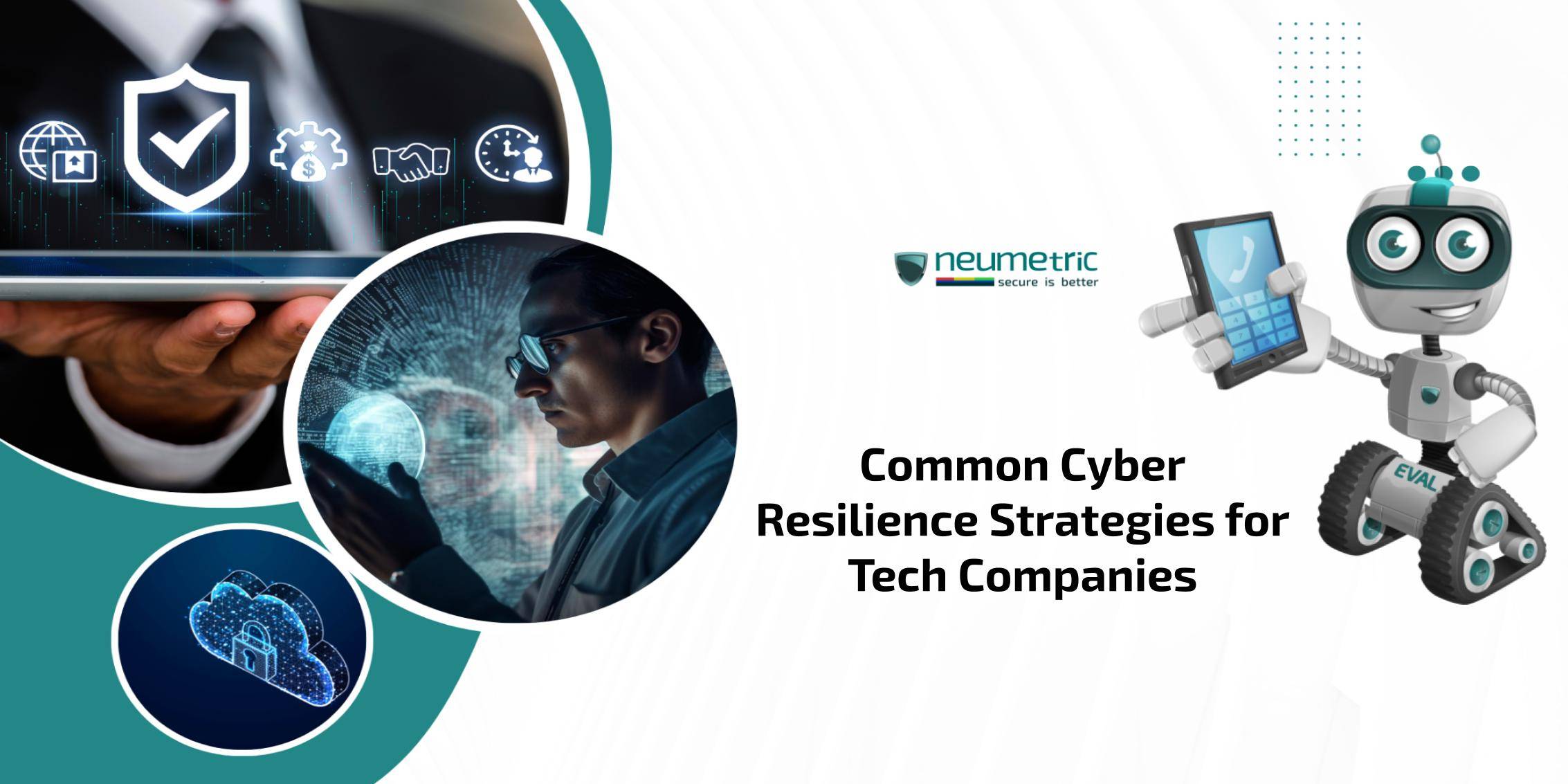Table of Contents
ToggleIntroduction
In the ever-evolving digital realm, the concept of cyber resilience has emerged as a linchpin for the survival & prosperity of tech companies. Cyber resilience represents a dynamic shift in cybersecurity strategy, acknowledging the inevitability of cyber threats & emphasizing an adaptive approach to security. It goes beyond the conventional mindset of fortifying digital perimeters & dives into the realm of readiness, response & recovery in the face of a cyber onslaught.
At its core, cyber resilience is a holistic strategy that encapsulates a company’s ability not only to thwart potential cyber threats but also to effectively navigate & mitigate the aftermath of a successful attack. Unlike traditional security models that focus solely on prevention, Cyber resilience strategies for tech companies recognizes that breaches are a matter of ‘when’ rather than ‘if.’ This paradigm shift reflects the harsh reality of today’s digital landscape, where the sophistication & frequency of cyber attacks continue to escalate. For tech companies, which often stand as the vanguards of innovation & information, cultivating cyber resilience is not just a prudent choice but an imperative necessity.
The importance of Cyber resilience strategies for tech companies extends far beyond safeguarding their proprietary data; it is intricately linked to maintaining customer trust & ensuring the integrity of interconnected digital ecosystems. A breach in one tech entity can reverberate through the intricate web of digital dependencies, affecting not only the targeted organization but also casting shadows on the reliability of the broader technological infrastructure. As we navigate this complex cyber terrain, the following exploration will delve into the crucial strategies that tech companies can adopt to bolster their cyber resilience, safeguard their operations & contribute to the overall stability of the digital landscape.
Implement Strong Access Controls for Cyber resilience strategies for tech companies
In the dynamic world of cybersecurity, crafting a robust defense mechanism starts with securing the front door—access controls. To equip Cyber resilience strategies for tech companies, safeguarding sensitive information is akin to fortifying a digital fortress & implementing strong access controls is the first line of defense.
- Multi-Factor Authentication [MFA]: One of the cornerstones of contemporary access security is the adoption of Multi-Factor Authentication [MFA]. Gone are the days of relying solely on passwords; MFA adds an extra layer of protection by requiring users to verify their identity through multiple means. Whether it’s a fingerprint scan, a text message code, or a smart card, MFA significantly reduces the risk of unauthorized access. Tech companies, dealing with intricate networks & proprietary data, can’t afford to overlook this simple yet potent measure in their cyber resilience playbook.
- Endpoint Protection: Tech ecosystems are a mosaic of interconnected devices & each endpoint presents a potential vulnerability. Endpoint protection involves securing individual devices like computers, laptops & mobile devices from malicious activities. Robust antivirus software, regular updates & real-time monitoring contribute to a comprehensive endpoint protection strategy. As the digital perimeter expands, ensuring the security of each device becomes paramount, forming a crucial pillar of cyber resilience for tech companies.
- Access Reviews: The landscape of personnel changes within a company is fluid & so is the access they require. Access reviews involve regularly assessing & updating user permissions to align with their roles & responsibilities. This proactive measure not only minimizes the risk of insider threats but also ensures that former employees or individuals with unnecessary access no longer pose a security risk. For tech companies managing intricate networks & sensitive projects, periodic access reviews are instrumental in maintaining a resilient cybersecurity posture.
Train Employees on Security
In the ever-evolving cyber battleground, your employees are both your greatest strength and, potentially, a chink in the armor. Training them on the nuances of cybersecurity isn’t just a nice-to-have; it’s a non-negotiable aspect of fortifying your tech company’s resilience against cyber threats.
- Security Awareness Training: Picture this: your employees are the first line of defense against cyber threats, but they can’t defend what they don’t understand. Enter security awareness training—the crash course in cybersecurity street smarts. It’s about making sure your team recognizes the red flags, understands the importance of strong passwords & can navigate the digital landscape with a keen eye for potential hazards. In a world where cyber threats disguise themselves as innocuous emails or enticing links, an educated team becomes an invaluable asset.
- Phishing Simulations: Phishing isn’t just for the open seas; it’s a digital menace that preys on the unsuspecting. Phishing simulations are like fire drills for the cyber world. They let your team experience the tactics hackers use in a controlled environment, helping them recognize the signs of a phishing attempt. It’s the digital equivalent of arming your employees with a sixth sense, allowing them to spot a phishing email from a mile away & thwart potential security breaches.
- Response Training: Cyber attacks are like storms – unpredictable & sometimes unavoidable. Response training prepares your employees for the worst-case scenario. It’s about having a well-drilled team that knows what to do when the alarm bells ring. From identifying the nature of an attack to implementing damage control measures, response training ensures your crew doesn’t just weather the storm but emerges stronger on the other side. In the dynamic world of cybersecurity, a well-prepared & trained team is your best bet for staying ahead of the curve.
Have an Incident Response Plan
In the cybersecurity realm, it’s not a matter of ‘if’ but ‘when’ an incident will occur. Having a robust Incident Response Plan [IRP] is like having a superhero on standby for the inevitable cyber battles your tech company might face.
- Detection & Analysis: The first line of defense in any cyber skirmish is early detection. It’s about having the right sensors & alarms in place to sniff out anomalies & potential threats. Once a threat is detected, the next step is analysis. Think of it like Sherlock Holmes investigating a digital crime scene. Understanding the nature & scope of the incident is crucial for crafting an effective response. This phase is where tech companies put on their cyber detective hats & get to the bottom of what’s going on.
- Containment Strategies: With the threat identified & analyzed, it’s time to contain the damage. Containment strategies are the digital equivalent of building a dam to stop a cyber flood. It involves isolating affected systems, cutting off the attacker’s access & preventing the incident from spreading like wildfire. The goal here is to minimize the impact & prevent further harm to your digital assets.
- Eradication & Recovery Steps: Once containment is achieved, it’s time to kick the attackers out for good. Eradication involves removing the threat entirely from your systems. Simultaneously, recovery steps are initiated to bring affected systems back to life. It’s the cyber equivalent of rebuilding a city after a disaster. Tech companies need a meticulous plan for eradicating the threat & ensuring a smooth recovery to resume normal operations.
- Post-Incident Analysis: The final act in the IRP saga is post-incident analysis. It’s not about pointing fingers; it’s about learning from the experience. What went wrong? What went right? How can we strengthen our defenses for next time? This introspective phase is vital for continuous improvement, turning each incident into a stepping stone toward a more resilient future. It’s the tech company’s way of saying, “Okay, that happened, but now we’re smarter, stronger & ready for whatever the digital world throws at us next.”
Maintain Secure Backups
Maintaining secure backups isn’t just a tech company safety net; it’s the digital version of having spare keys hidden somewhere safe.
- Air-Gapped Backups: These backups are isolated from the regular network, making them impervious to the cyber chaos happening on the frontline. It’s like having a backup fortress hidden away, ensuring that even if the primary kingdom falls, the crown jewels (your critical data) remain intact & untouchable.
- Immutable Storage: Immutable storage is like a time lock on your digital treasure chest. Once data is stored, it becomes unchangeable & untouchable, even by the most cunning cyber tricksters. It’s the ultimate defense against data tampering. In a world where data integrity is non-negotiable, immutable storage ensures that your backups remain pristine & unaltered, ready to be summoned at a moment’s notice.
- Test Restoration: Having a backup is one thing; knowing it actually works is another. Test restoration is like a dress rehearsal for the big show. It involves regularly checking that your backups aren’t just sitting there looking pretty but can actually be brought back to life seamlessly. It’s the tech company’s way of ensuring that when the cyber curtain falls, the backup actors know their lines & can step in without missing a beat.
Adopt a Zero Trust Model
For tech companies, embracing a Zero Trust Model is like putting on a cyber suit of armor – it might look cool, but more importantly, it keeps you safe.
- Verify All Users & Devices: In the world of Zero Trust, trust is a precious commodity & everyone has to earn their badge. Verifying all users & devices is like having a bouncer at the digital club entrance. No entry without proper identification. Whether it’s Susan from HR or a device named Bob, everyone gets thoroughly checked before stepping into the digital VIP lounge. It’s about making sure that only the legit folks get through the velvet rope.
- Use Least-Privilege Access: In the Zero Trust universe, privileges are doled out like superhero powers – sparingly. Least-privilege access means that each user & device gets only the powers they absolutely need to do their job – no more, no less. It’s the ultimate principle of ‘need to know.’ This way, even if a cyber villain manages to sneak in, they’re like a superhero without their cape – severely limited in causing digital havoc.
- Microsegment Networks: Picture your network as a bustling city. In the Zero Trust Model, microsegmentation is like creating individual neighborhoods with their own security gates. Each part of the network is isolated, so even if a villain manages to break into one neighborhood, they’re still a long way from taking over the entire city. It’s about minimizing the damage radius & turning your digital empire into a fortress of cyber solitude.
- Encrypt Data: Encrypting data is like speaking in a secret code that only the trusted few can understand. In the Zero Trust world, assuming that the digital airwaves might be tapped, data encryption becomes the norm. It ensures that even if someone manages to eavesdrop, all they get is a jumble of nonsensical characters. It’s the modern-day equivalent of whispering secrets in a crowded room.
Conclusion
In the grand tapestry of cybersecurity, our exploration into common cyber resilience strategies for tech companies reveals a crucial truth: the digital landscape is a dynamic arena where adaptability is the key to survival. From implementing multi-factor authentication to embracing the ethos of Zero Trust, we’ve deciphered the intricate dance between security & innovation. The key takeaway resonates clear: cyber resilience is not a destination but a continuous journey, an ongoing commitment to fortify against the relentless tide of cyber threats.
As we draw the curtain on the Cyber resilience strategies for tech companies, the resounding call is for continued vigilance. The digital frontier evolves & so do the tactics of cyber adversaries. Tech companies must remain vigilant, agile & proactive in their defense strategies. It’s a perpetual commitment to stay ahead of the curve, recognizing that resilience is not just a one-time investment but a culture that permeates every line of code & every digital interaction. In this ever-shifting cyber symphony, the harmony of security & innovation is the anthem that ensures tech companies navigate the digital seas with confidence & durability.
FAQ
Why is it so crucial for tech companies to adopt a Zero Trust Model?
By verifying all users, limiting access privileges, microsegmenting networks & encrypting data, it’s like turning your digital realm into an impenetrable fortress. In today’s cyber Wild West, it’s not about trusting everyone by default; it’s about making them earn that trust, one digital badge at a time.
How do air-gapped backups work & why are they so important for tech companies?
Think of air-gapped backups as the secret vault where you stash your most precious digital treasures. These backups are like Fort Knox for your data, isolated from the regular network. It’s the ultimate insurance policy. Even if the cyber dragons breach the frontlines, your critical data remains untouchable in this hidden fortress. In the game of cybersecurity chess, air-gapped backups are your unbeatable queen, ready to protect your kingdom.
What’s the ongoing commitment in cyber resilience & why is continued vigilance necessary?
Cyber resilience is not a one-and-done deal; it’s a lifestyle. The digital landscape evolves & so do the tactics of cyber adversaries. Staying resilient means staying on your toes, constantly adapting to new threats. It’s a commitment to fortify every line of code, every access point & every digital interaction. The need for continued vigilance is like having a security guard for your digital castle – the world may change, but your commitment to safeguarding your kingdom remains unwavering.





